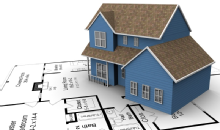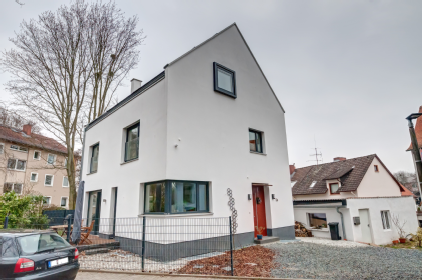

 The first Efficiency House Plus in Bad Homburg has Pluggit installations
The first Efficiency House Plus in Bad Homburg has Pluggit installations
The optimum overall energy balance of the Efficiency House Plus has convinced its owners.
The Efficiency House Plus of Steffen Klawitter and his family generates more energy than it uses. This is possible thanks to efficient construction, a photovoltaic system on the roof that produces approximately 9,000 kilowatt hours (kWh) of electricity per annum, and components which are also prescribed for passive houses. Perhaps most importantly a domestic ventilation system with heat recovery.
The overall energy balance of the Efficiency House Plus is better than that of a passive house. The photovoltaic system produces around 9,000 kWh every year. Excess electricity not used in the house can be fed into the public grid and remunerated according to specified rates. “Even with the highly changeable weather conditions at the beginning and in the middle of May, our system produced around 15 to 20 kWh more than we needed. In total our house produced around 500 kWh more than we needed in May,� explains Klawitter, owner of the house. The 22 kWh per square metre per year heating required does exceed the value of a passive house (15 kWh per square metre per year); however, this fact is neutralised by the sum total of the energy efficient systems. These include - alongside the photovoltaic system and domestic ventilation system - a firewood stove with buffer tank and heat pump; all of which facilitate CO2 neutrality.
Construction costs comparable with KW55 detached houses
The new Klawitter family home stands out thanks to its low construction costs: These remain within the normal range for detached houses in accordance with KfW 55 standards - despite the energy efficiency measures. According to the statement of the executive office “bb22 architekten+stadtplaner� from Frankfurt am Main , this is due in part to the fact that the extremely high insulation requirements of this solid house - in contrast with passive houses - do not have to be taken into consideration. Martin Wilhelm, the architect responsible comments: “The house in Bad Homburg is not at all an overpriced pilot project, but rather provides a platform for a cost concept. Where possible, energy efficient construction techniques are utilized, but the exceptionally expensive insulation requirements of passive houses - at least as is sometimes the case - can be avoided. When all’s said and done, the goal is to make these construction methods more feasible on the large scale.�
Pilot project is encouraged and supported
The Klawitter family home has character. It is sponsored by the city Bad Homburg. Michael Korwisi, Lord Mayor of the city, sees an opportunity to set a path-breaking standard through sponsoring the project: “For the first time the city is sponsoring an Efficiency House Plus, and this is with good reason. We see a future in sustainable construction. When all’s said and done, houses are among the biggest consumers of power.� The building is also part of the German Federal Ministry for Transport, Building and Urban Development’s research programme. For this reason it is also being comprehensively monitored. The owner and industrial partners hope to be able to draw interesting conclusions from the interplay of the individual elements and about the energy balance of the Efficiency House Plus. Long term monitoring started in June, which will analyse and evaluate energy consumption and production, as well as interior warmth, over the course of the next two years. Alongside the photovoltaic system, the following components essentially form the energy efficient total package: triple-glazed windows with a higher irradiation gain than standard windows; an air-to-water heat pump; a roof construction with minimum heat permeability; a brine pipeline network around the house, which cools in the summer, heats in the winter; and above all else the Pluggit fan supported domestic ventilation system with heat heat recovery.
Domestic ventilation system contributes to energy efficiency
In accordance with standard DIN 1946 Part 6, domestic ventilation systems ensure that the minimum air exchange requirements of building are met. Following prior analysis and calculation, the required amount of air is simultaneously supplied and extracted from individual rooms. In this way, manual window ventilation is rendered obsolete. Furthermore, thanks to the integrated heat recovery system, colder air is warmed up by the warmer extracted air. Using this system, more than 60 percent of heat loss caused by ventilation can be avoided. Humidity can also be reliably extracted, which helps effectively to prevent mould and damp damage.
The system can be expanded by an array of supplementary technical features: Specifically the PluggVoxx air-treatment system removes aggressive pollen grains and dust particles from the air so that those with allergies can also breathe freely. Fine dust particles can also be caught with an additional electro-statically charged filter.
Partner company ensures trouble-free installation
The company Fehl & Sohn GmbH from Freiensteinau took on responsibility for the installation of the domestic ventilation system. The company fits around 500 detached houses every year with Pluggit systems; the partnership has grown together over the last seven years, as Managing Director Oliver Fehl explains: “Together with Pluggit and a small number of craft businesses, we made a great contribution a few years ago to the development of a useful and consistent solution concept for controlled domestic ventilation systems with heat recovery in prefab houses. The concept we developed is spreading today, among other areas in prefab house construction companies, property developers and architects all over Germany.�
Owner wants to set a good example
The good reputation of Pluggit ventilation systems proved decisive in the builder’s decision to purchase: “I considered Pluggit the technological market leader and got in contact with the management. Ultimately it was the flexibility and performance of the system which convinced me. Especially in the initial phase, in which the building materials and new furniture dry out, we feel safer with a mechanical ventilation system, that these harmful substances can be reliably extracted.� The security aspect was also convincing: “When I leave the house I don’t have to worry that I might have left a window open and that I would have given a burglar an easy way to get in,� says Klawitter. He is also particularly impressed with the energy values, especially the degree of heat recovery. Klawitter’s interest extends far beyond the conventional involvement of an owner with his new home: He has a personal and occupational interest in the area of sustainable investment and energy efficiency. With his home he hopes to lead the way for others and to find copycats: “It is no longer difficult today to build a beautiful home that produces more energy than a family uses.�
Fact sheet:
| Address: | Lange Meile, 63862 Bad-Homburg |
|---|---|
| Type of house: | New build detached house |
| Building standard: | Efficiency House Plus |
| Building owner: | Klawitter family |
| Architect: | bb22 Architekten + Stadtplaner, Frankfurt am Main |
| Specialist heating, plumbing and ventilation company: | Fehl & Sohn GmbH, Freiensteinau |
| Ventilation system: | Ventilation system: Central ventilation system with heat recovery, ventilation device type Pluggit AP 460 (WRG in accordance with the definitions of the German Institute for Building Technology (Deutsches Institut für Bautechnik - DIBt): 85,7%; air flow volume up to 450 m³/h; Electro-efficiency: (2.066) Wh/m³); air distribution system in the insulation with flat channels type PluggFlex PK150 and PK200, Pluggit silencer SD180-P and central air distribution system VT; extra equipment: Pluggit AeroFresh plus air humidifier system |
More

360° presentation of a detached house - equipped with Pluggit domestic ventilation system
Learn more renovation
renovation
 new buildings
new buildings





